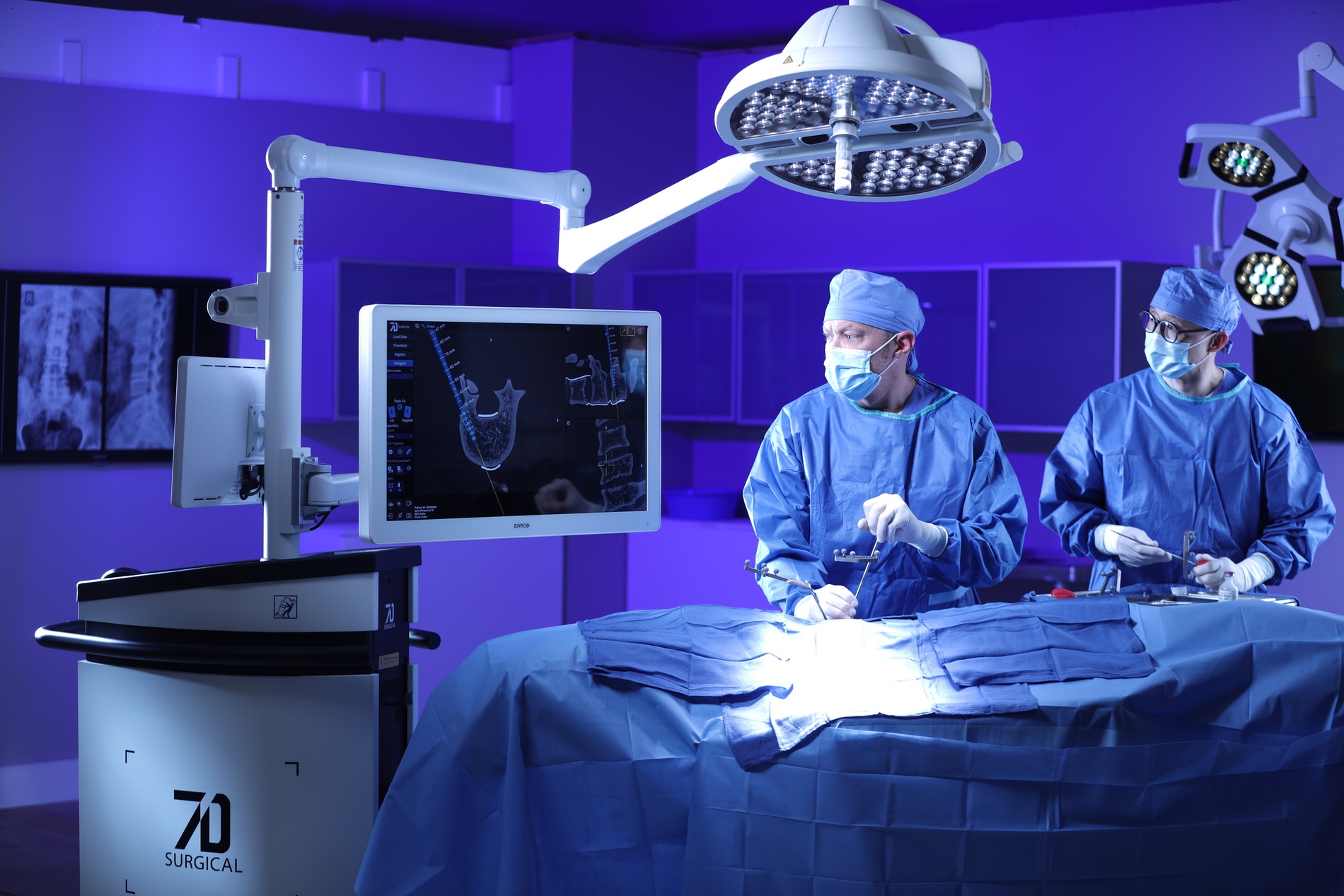the science
Research Studies
7D Surgical is committed to the development of evidence supporting improvements to scientific advancements and clinical knowledge in patient outcomes around the world.

AME Case Reports, 6. (2022)
Yeretsian T., Lai C., Guha D., Ramjist J., Yang V. X.
Machine-vision image guided C4-C5 unilateral cervical pedicle screw insertion: case report and review of literature.
A 49-year-old man presented with a traumatic sagittal split fracture of C4 and a left lateral mass fracture of C5 with anterior depression and 50% height loss, strain of the interspinous/supraspinous ligaments, fluid within the left C4-C5 facet joint, Klippel-Feil syndrome with autofusion of the...
Read Study
Interdisciplinary Neurosurgery, 29, 101561. (2022)
Abdelrahman A., Bangash O. K., Bala A.
Percutaneous posterior lumbar interbody fusion using optical topographic navigation: Operative technique.
This operative technique describes a novel application of 7D navigation system in a minimally invasive approach for posterior lumbar interbody fusion with percutaneous screw placement. This technique was found to be efficient, reliable and requires a systematic study to further evaluate long-term...
Read Study
Journal of Pediatric Orthopedics, 43(5), e331. (2023)
Comstock C. P., Wait E.
Novel Machine Vision Image Guidance System Significantly Reduces Procedural Time and Radiation Exposure Compared With 2-dimensional Fluoroscopy-based Guidance in Pediatric Deformity Surgery.
MvIGS reduced the operative time by 63.6 minutes and reduced intraoperative radiation exposure by 66%, which may play an important role in reducing the risks to the surgeon and operating room staff associated with radiation in spinal surgery procedures.
Read Study
European Spine Journal, 1-9. (2023)
Lim K. B. L., Yeo I. S. X., Ng S. W. L., Pan W. J., Lee N. K. L.
The machine-vision image guided surgery system reduces fluoroscopy time, ionizing radiation and intraoperative blood loss in posterior spinal fusion for scoliosis.
MvIGS for screw insertion in PSF contributed to a significant reduction in intraoperative radiation exposure and fluoroscopy time, as well as blood loss and length of stay. The real-time feedback and ability to visualize the pedicle in 3D with MvIGS enabled greater curve correction without increa...
Read Study
In Orthopaedic Proceedings (Vol. 104, No. SUPP_12, pp. 68-68). Bone & Joint. (Dec 2022)
Yee N., Lorio C., Shkumat N., Rocos B., Ertl-Wagner B., Green A., Camp, M.
"Ultra-low Dose" CT without sedation is feasible and should be considered as part of the preoperative optimization pathway in paediatric neuromuscular scoliosis patients.
“Ultra-low dose” CT scans without sedation were feasible in paediatric patients with neuromuscular scoliosis. The effective dose was similar between the standard preoperative spinal XR and “ultra-low dose” CT scans. The “ultra-low dose” CT scan allowed accurate assessment of the anatomy, aided in...
Read Study
Clinical Neurology and Neurosurgery, 212, 107085 (2022)
Zagzoog N., Zadeh G., Lin V., Yang V. X.
Perspective review on applications of optics in skull base surgery.
The use of optic technology in skull base surgeries has the potential to revolutionize the field of medicine, particularly neurosurgery and neurology. In this review, the present the past, present, and future of skull-base surgery is explored, with an emphasis on the applications of optical topog...
Read Study
Interdisciplinary Neurosurgery, 30, 101641 (2022)
Malacon K., Fatemi P., Zygourakis C. C.
First reported use of machine vision image guided system for unstable thoracolumbar fusion: Technical case report.
Spinal instability and shifting anatomy due to unstable spinal fratures can make spinal fixation challenging. FLASH Navigation resulted in accurate registration, easy and efficient workflow and limited radiation in a T7-L1 posterolateral fusion for a traumatic unstable thoracolumbar fracture.
Read Study
AME Case Reports, 6.
Yeretsian T., Lai C., Guha D., Ramjist J., Yang V. X.
Machine-vision image guided C4-C5 unilateral cervical pedicle screw insertion: case report and review of literature.
Image-guided neuronavigation was used to improve the accuracy and the safety of subaxial cervical pedicle screw placement, given their increased difficulty of cannulation relative to the larger pedicles in the thoracolumbar spine.
Read Study
Interdisciplinary Neurosurgery, 29, 101561
Abdelrahman A., Bangash O. K., Bala A.
Percutaneous posterior lumbar interbody fusion using optical topographic navigation: Operative technique
This operative technique outlines an efficient technique with placement of navigated percutaneous pedicle screws using an optical topographic navigation approach combined with open placement of interbody cage using a midline open incision, without extensive dissection and intraoperative radiation ex
Read Study
International Journal of Spine Surgery, August 2022
Geoffrey Stewart
Visible Light Navigation in Spine Surgery: My Experience With My First 150 Cases
This study is a retrospective cohort investigation of 150 consecutive patients who underwent spinal instrumentation placement utilizing visible light navigation. The objective was to determine the utility of the navigation system and its strengths and weaknesses as well as to assess patient safety
Read Study
Book a Demo
Ready to get a full demo of the 7D Surgical System? Click the button below to get scheduled.
book my demo